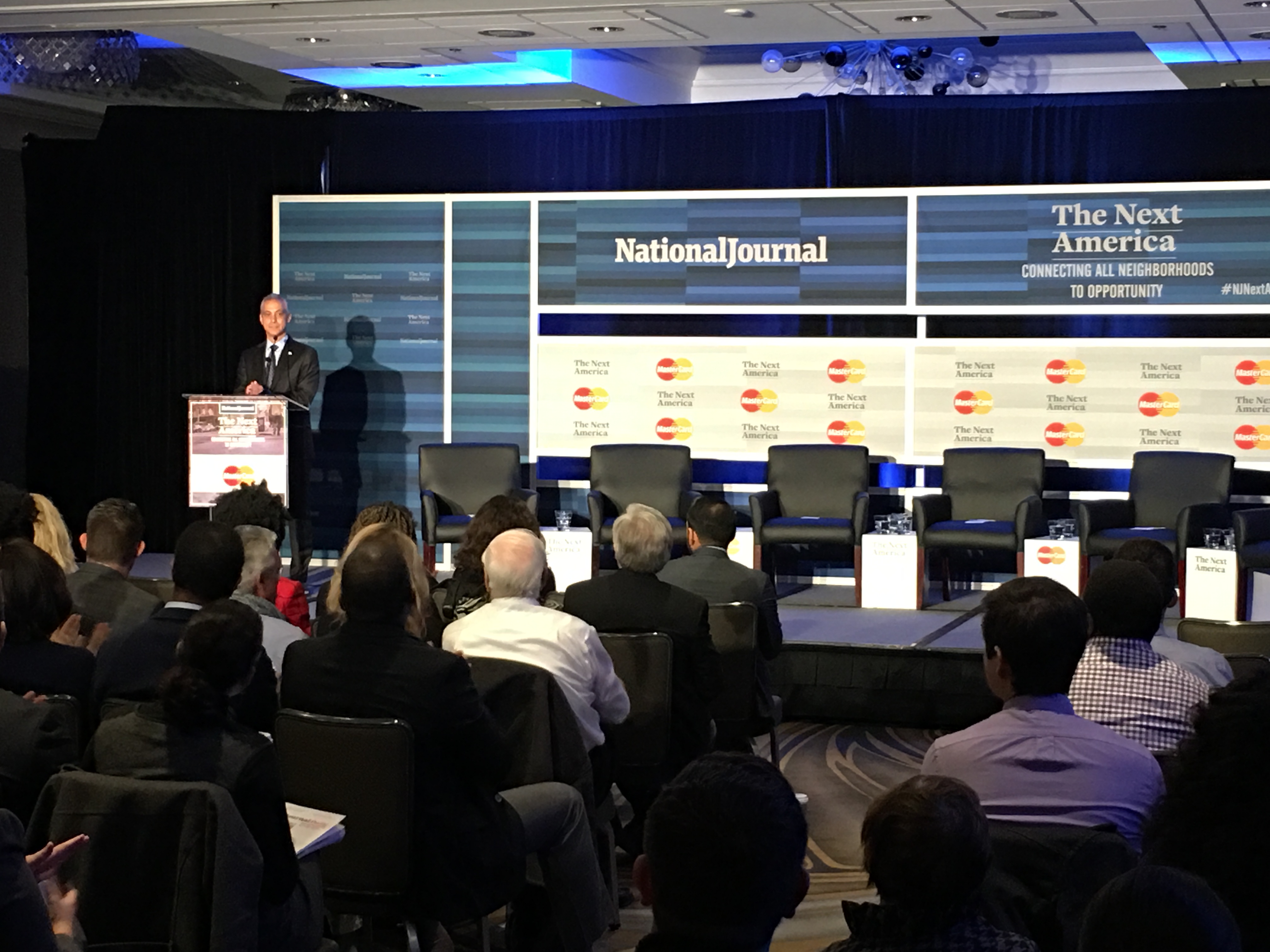By Lily Singh and Kierra Gray
Mayor Rahm Emanuel highlighted Tuesday how Chicago is investing public dollars to attract private sector dollars, especially in parts of the city that have failed to attract businesses.
“Where you invest in either a skilled work force, transportation, public schools, parks, housing…using those leverage points of public dollars [can] generate the private sector development alongside,” Emanuel said in the keynote speech at the National Journal conference. Corporate and civic leaders gathered for the meeting at the Hyatt Chicago Magnificent Mile.
The morning conference on “The Next America: Connecting All Neighborhoods to Opportunity” focused on Emanuel’s keynote speech and included a follow-up one-on-one with the mayor hosted by Ron Brownstein, editorial director of Atlantic Media.
The schedule included two separate panels of speakers that followed reinforced the need for education and connecting business leaders with city college students and the neighborhoods.
“Investing in people, investing in transportation, gives the private sector the confidence to move and bring jobs to the city of Chicago,” Emanuel said.
Investing in transportation has been a priority for Emanuel as mayor. After seeing a decline in ridership on the Red Line south of the Loop, it was shut down for five months to rebuild 10.2-miles of track as part of the Building a New Chicago initiative. According to the Chicago Transit Authority, the project cost $425 million.
“We took seven neighborhoods and created this Neighborhoods Now strategy. Aggregating our investments, giving the private sector the confidence that if we’re putting our resources here, draft right along side us to make your private sector investments.”
The neighborhoods that are part of the initiative include Englewood, Pullman, Rogers Park, Uptown, Little Village, Bronzeville, and the Eisenhower Corridor.
“Mariano’s, another grocery store, is going into Bronzeville, the very place that we put in new public transportation, two new bridges and a new park district facility swimming and arts center,” Emanuel said. “There’s other things going on in the whole area of Bronzeville but it gave them the confidence of what is happening.”
The city is working to bring education and skills acquisition to Chicago residents so they are able to take advantage of available jobs.
Brownstein began the Q & A by asking, “To what extent is the growth that you’re experiencing overall reaching to the South Side, to the West Side, to all the communities in Chicago?”
Emanuel answered with a no and and an explanation.
“Around the city, people will be paying $4,000 or $5,000 bonuses just to sign up a truck driver,” Emanuel said. “And so those opportunities exist but the skill shortage – gap – is real.”
The gap means some good jobs don’t reach out to people in all the communities,
“The degree, the education, the skill is the biggest piece of getting every neighborhood [and] everybody in the neighborhood access to a thriving job market,” Emanuel said.
Emanuel said the strategy is to have an educational plan post high school, making high school only a milestone in your educational journey and not the end goal.
The recent Chicago Star Scholarship is a step towards making this plan a reality. Beginning in City College’s Fall 2015 semester, Spring 2015 graduates of Chicago Public Schools and those that follow will be able to pursue an associate degree for free. The students must have a B average and test completion-ready in math and English.
The job opportunities in Chicago have been increased in recent weeks with Motorola Solutions, ConAgra and Oscar Mayer all announcing moves of business to the city. Oscar Mayer is moving their headquarters to the city from Madison, Wis.
Chancellor Cheryl Hyman of City Colleges Chicago said that there is more not just a skills gap, but an information gap as well.
“What I’m also looking to do in addition to working with employers like Aon, with closing the skills gap, is making sure that our programs are relevant, having the employers at the table trying to close the training gap, … to close the connection gap. I also must figure out a way to close the information gap,” Hyman said during the first panel discussion.
“I know that there’s 600,000 jobs coming over these seven industries that the mayor and I are focused on but does every Chicagoan know that,” Hyman said. “Do they know that and do they know how to take advantage of that?”


